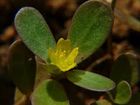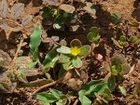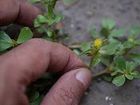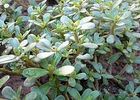Note: This is a project under development. The articles on this wiki are just being initiated and broadly incomplete. You can Help creating new pages.
Difference between revisions of "Portulaca oleracea - Purslane"
Chaithrika (talk | contribs) (+Common names) |
|||
| (38 intermediate revisions by 2 users not shown) | |||
| Line 1: | Line 1: | ||
| − | [[File:Portulaca oleracea.JPG|thumb|right|''Dudagorai'', ''Lunia'', '' | + | [[File:Portulaca oleracea.JPG|thumb|right|''Dudagorai'', ''Lunia'', ''Purslane'', ''Portulaca oleracea'']] |
| + | '''Portulaca oleracea''' is an annual succulent in the family Portulacaceae, which may reach 40 centimetres (16 in) in height.Approximately forty cultivars are currently grown. | ||
| + | ==Uses== | ||
| + | {{Uses|Snake bites}}, {{Uses|Boils}}, {{Uses|Snakebites}}, {{Uses|Sores}}, {{Uses|Skin eruptions}}, {{Uses|Pain from bee stings}}, {{Uses|Bacillary dysentery}}, {{Uses|Diarrhea}}, {{Uses|Hemorrhoids}}, {{Uses|Postpartum bleeding}}, {{Uses|Intestinal bleeding}}, {{Uses|Cold}}, {{Uses|Weak digestion}}. | ||
| − | + | ===Food=== | |
| + | Portulaca oleracea can be used in Food. Entire shoot is cooked as vegetable. Young shoots are consumed as salad. Leaves dried and stored for use in times of scarcity.<ref name="Forest foods of Western Ghat"/> | ||
| − | + | ==Parts Used== | |
| + | {{Parts Used|Stem}}, {{Parts Used|Leaves}}, {{Parts Used|Flowers}} | ||
| − | == | + | ==Chemical Composition== |
| − | + | Alpha-linolenic, 0.01 mg/g of eicosapentaenoic acid, vitamin A, vitamin C, Vitamin E (alpha-tocopherol) and some vitamin B and carotenoids.<ref name="chemical composition"/> | |
| − | |||
| − | == | + | ==Common names== |
| − | + | {{Common names|kn=ದೊಡ್ಡ ಗೋಣಿ ಸೊಪ್ಪು Dodda goni soppu|ml=Koluppa|sa=Loni, Lonika|ta=Koli-k-kirai|te=Boddupavilikoora, Boddupavilikura|hi=Khursa, Kulfa|en=Common Indian Parselane|pa=Dhamni}}<ref name="Common names"/> | |
| − | |||
| − | |||
| − | |||
| − | |||
| − | == | + | ==Properties== |
| + | Reference: Dravya - Substance, Rasa - Taste, Guna - Qualities, Veerya - Potency, Vipaka - Post-digesion effect, Karma - Pharmacological activity, Prabhava - Therepeutics. | ||
| + | ===Dravya=== | ||
| − | + | ===Rasa=== | |
| − | + | Amla | |
| + | ===Guna=== | ||
| + | Guru (Heavy), Ruksha (Dry) | ||
| + | ===Veerya=== | ||
| + | Ushna (Hot) | ||
| + | ===Vipaka=== | ||
| + | Kaphahar and Vatahar, Pittakara, Chakshuya, Vanidoshhar | ||
| + | ===Karma=== | ||
| − | == References == | + | ===Prabhava=== |
| − | + | ||
| − | < | + | ===Nutritional components=== |
| − | <ref name=" | + | Portulaca oleracea Contains the Following nutritional components like - Vitamin A, B1, B2, B3, B6, C and E; Oleracein A, Oleracein BZ, Oleracein E, Hesperidin; Calcium, Iron, Magnesium, Manganese, Phosphorus, Potassium, Sodium, Zinc<ref name="Forest foods of Western Ghat"/>. |
| + | |||
| + | ==Habit== | ||
| + | {{Habit|Annual herb}} | ||
| + | |||
| + | ==Identification== | ||
| + | ===Leaf=== | ||
| + | {{Leaf|Simple|Lobed or unlobed but not separated into leaflets|Leaf arrangement is alternate there is one leaf per node along the stem and the edge of the leaf blade is entire (has no teeth or lobes)}}<ref name="Leaf"/> | ||
| + | |||
| + | ===Flower=== | ||
| + | {{Flower|Unisexual|2-4cm long|Yellow|10|There are two or more ways to evenly divide the flower (the flower is radially symmetrical)}} | ||
| + | |||
| + | ===Fruit=== | ||
| + | {{Fruit|General|4–7 mm|The fruit is dry and splits open when ripe||Many}} | ||
| + | |||
| + | ===Other features=== | ||
| + | |||
| + | ==List of Ayurvedic medicine in which the herb is used== | ||
| + | |||
| + | ==Where to get the saplings== | ||
| + | ==Mode of Propagation== | ||
| + | {{Propagation|Seeds}}, {{Propagation|Cuttings}}. | ||
| + | |||
| + | ==How to plant/cultivate== | ||
| + | Requires a moist light rich well-drained soil in a sunny position<ref name="How to plant/cultivate"/>. Portulaca oleracea is available throughout the year<ref name="Forest foods of Western Ghat"/>. | ||
| + | |||
| + | ==Commonly seen growing in areas== | ||
| + | {{Commonly seen|At meadows}}, {{Commonly seen|Borders of forests and fields}}. | ||
| + | |||
| + | ==Photo Gallery== | ||
| + | <gallery class="left" caption="" widths="140px" heights="140px"> | ||
| + | Lunia5.jpg | ||
| + | Lunia4.jpg | ||
| + | Lunia2.jpg | ||
| + | Lunia 3.jpg | ||
| + | Lunia1.jpg | ||
| + | File:Portulaca oleracea Ja ao 1.JPG|Capsule | ||
| + | </gallery> | ||
| + | |||
| + | ==References== | ||
| + | <references> | ||
| + | <ref name="chemical composition">[https://www.sciencedirect.com/science/article/pii/S0378874112006393?via%3Dihub Portulaca oleracea L on science direct]</ref> | ||
| + | |||
| + | <ref name="Leaf">[https://gobotany.newenglandwild.org/species/portulaca/oleracea/ Characteristics]</ref> | ||
| + | |||
| + | <ref name="Common names">[https://sites.google.com/site/indiannamesofplants/via-species/p/portulaca-oleracea Common names]</ref> | ||
| + | |||
| + | <ref name="How to plant/cultivate">[https://www.pfaf.org/user/plant.aspx?LatinName=Portulaca+oleracea Cultivation details]</ref> | ||
| + | |||
| + | <ref name="Forest foods of Western Ghat">"Forest food for Northern region of Western Ghats" by Dr. Mandar N. Datar and Dr. Anuradha S. Upadhye, Page No.127, Published by Maharashtra Association for the Cultivation of Science (MACS) Agharkar Research Institute, Gopal Ganesh Agarkar Road, Pune</ref> | ||
</references> | </references> | ||
| − | == External Links == | + | ==External Links== |
| − | + | * [https://www.nutrition-and-you.com/purslane.html Purslane nutrition facts] | |
| − | *[https:// | + | * [https://www.hindawi.com/journals/tswj/2014/951019/ Purslane Weed (Portulaca oleracea): A Prospective Plant Source of Nutrition] |
| − | + | * [http://tropical.theferns.info/viewtropical.php?id=Portulaca+oleracea+sativa Portulaca oleracea L on useful trophical plants] | |
| + | * [https://wimastergardener.org/article/common-purslane-portulaca-oleracea/ Portulaca oleracea L on wimastergarden.org] | ||
| + | * [https://floridata.com/Plants/Portulacaceae/Portulaca+oleracea/1220 Portulaca oleracea L on floridata.com/] | ||
[[Category:Herbs]] | [[Category:Herbs]] | ||
| + | [[Category:Portulacaceae]] | ||
Latest revision as of 12:24, 16 November 2021
Portulaca oleracea is an annual succulent in the family Portulacaceae, which may reach 40 centimetres (16 in) in height.Approximately forty cultivars are currently grown.
Contents
- 1 Uses
- 2 Parts Used
- 3 Chemical Composition
- 4 Common names
- 5 Properties
- 6 Habit
- 7 Identification
- 8 List of Ayurvedic medicine in which the herb is used
- 9 Where to get the saplings
- 10 Mode of Propagation
- 11 How to plant/cultivate
- 12 Commonly seen growing in areas
- 13 Photo Gallery
- 14 References
- 15 External Links
Uses
Snake bites, Boils, Snakebites, Sores, Skin eruptions, Pain from bee stings, Bacillary dysentery, Diarrhea, Hemorrhoids, Postpartum bleeding, Intestinal bleeding, Cold, Weak digestion.
Food
Portulaca oleracea can be used in Food. Entire shoot is cooked as vegetable. Young shoots are consumed as salad. Leaves dried and stored for use in times of scarcity.[1]
Parts Used
Chemical Composition
Alpha-linolenic, 0.01 mg/g of eicosapentaenoic acid, vitamin A, vitamin C, Vitamin E (alpha-tocopherol) and some vitamin B and carotenoids.[2]
Common names
| Language | Common name |
|---|---|
| Kannada | ದೊಡ್ಡ ಗೋಣಿ ಸೊಪ್ಪು Dodda goni soppu |
| Hindi | Khursa, Kulfa |
| Malayalam | Koluppa |
| Tamil | Koli-k-kirai |
| Telugu | Boddupavilikoora, Boddupavilikura |
| Marathi | NA |
| Gujarathi | NA |
| Punjabi | Dhamni |
| Kashmiri | NA |
| Sanskrit | Loni, Lonika |
| English | Common Indian Parselane |
Properties
Reference: Dravya - Substance, Rasa - Taste, Guna - Qualities, Veerya - Potency, Vipaka - Post-digesion effect, Karma - Pharmacological activity, Prabhava - Therepeutics.
Dravya
Rasa
Amla
Guna
Guru (Heavy), Ruksha (Dry)
Veerya
Ushna (Hot)
Vipaka
Kaphahar and Vatahar, Pittakara, Chakshuya, Vanidoshhar
Karma
Prabhava
Nutritional components
Portulaca oleracea Contains the Following nutritional components like - Vitamin A, B1, B2, B3, B6, C and E; Oleracein A, Oleracein BZ, Oleracein E, Hesperidin; Calcium, Iron, Magnesium, Manganese, Phosphorus, Potassium, Sodium, Zinc[1].
Habit
Identification
Leaf
| Kind | Shape | Feature |
|---|---|---|
| Simple | Lobed or unlobed but not separated into leaflets | Leaf arrangement is alternate there is one leaf per node along the stem and the edge of the leaf blade is entire (has no teeth or lobes) |
Flower
| Type | Size | Color and composition | Stamen | More information |
|---|---|---|---|---|
| Unisexual | 2-4cm long | Yellow | 10 | There are two or more ways to evenly divide the flower (the flower is radially symmetrical) |
Fruit
| Type | Size | Mass | Appearance | Seeds | More information |
|---|---|---|---|---|---|
| General | 4–7 mm | The fruit is dry and splits open when ripe | Many | {{{6}}} |
Other features
List of Ayurvedic medicine in which the herb is used
Where to get the saplings
Mode of Propagation
How to plant/cultivate
Requires a moist light rich well-drained soil in a sunny position[5]. Portulaca oleracea is available throughout the year[1].
Commonly seen growing in areas
At meadows, Borders of forests and fields.
Photo Gallery
References
- ↑ 1.0 1.1 1.2 "Forest food for Northern region of Western Ghats" by Dr. Mandar N. Datar and Dr. Anuradha S. Upadhye, Page No.127, Published by Maharashtra Association for the Cultivation of Science (MACS) Agharkar Research Institute, Gopal Ganesh Agarkar Road, Pune
- ↑ Portulaca oleracea L on science direct
- ↑ Common names
- ↑ Characteristics
- ↑ Cultivation details
External Links
- Ayurvedic Herbs known to be helpful to treat Snake bites
- Ayurvedic Herbs known to be helpful to treat Boils
- Ayurvedic Herbs known to be helpful to treat Snakebites
- Ayurvedic Herbs known to be helpful to treat Sores
- Ayurvedic Herbs known to be helpful to treat Skin eruptions
- Ayurvedic Herbs known to be helpful to treat Pain from bee stings
- Ayurvedic Herbs known to be helpful to treat Bacillary dysentery
- Ayurvedic Herbs known to be helpful to treat Diarrhea
- Ayurvedic Herbs known to be helpful to treat Hemorrhoids
- Ayurvedic Herbs known to be helpful to treat Postpartum bleeding
- Ayurvedic Herbs known to be helpful to treat Intestinal bleeding
- Ayurvedic Herbs known to be helpful to treat Cold
- Ayurvedic Herbs known to be helpful to treat Weak digestion
- Herbs with Stem used in medicine
- Herbs with Leaves used in medicine
- Herbs with Flowers used in medicine
- Herbs with common name in Kannada
- Herbs with common name in Hindi
- Herbs with common name in Malayalam
- Herbs with common name in Tamil
- Herbs with common name in Telugu
- Herbs with common name in Punjabi
- Herbs with common name in Sanskrit
- Herbs with common name in English
- Habit - Annual herb
- Index of Plants which can be propagated by Seeds
- Index of Plants which can be propagated by Cuttings
- Herbs that are commonly seen in the region of At meadows
- Herbs that are commonly seen in the region of Borders of forests and fields
- Herbs
- Portulacaceae






